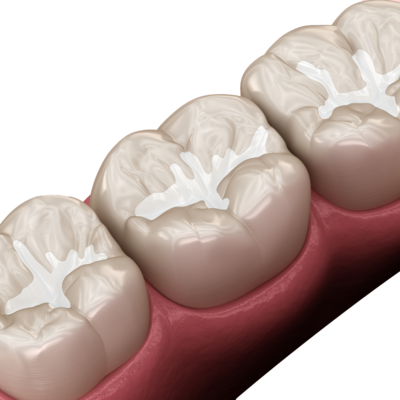
A dental sealant is a thin, protective coating applied to the chewing surfaces of our teeth. The material of a sealant has an adhesive that bonds with tooth enamel, to fill in the deep pits and grooves that commonly catch food. This is the most common place for children to develop a cavity.
A sealant changes the chewing surface so that there are no longer deep crevices to collect dental plaque. By filling in those pits and grooves and preventing plaque accumulation, a sealant prevents cavities before they start! The smooth surface a sealant creates repels plaque and food debris and makes your child’s teeth easier to clean.
Anyone with teeth is a good candidate for sealants! However, young children’s permanent molars begin erupting into their mouths around age six. At this time, most children are not adept at manipulating a toothbrush to properly clean away all of the dental plaque on their teeth. By placing dental sealants on the molars, we can create a surface that is easier to clean for a young child.
Dental insurance companies support the use of sealants and tend to cover them at 100% for children up to a certain age.
Some parents may find the various preventive options for children confusing. Sealants and fluoride treatments do both help protect your child’s teeth against cavity-causing bacteria, but they act in different ways. Sealants physically block out bacteria and decay from the grooves on the chewing surface of teeth. Fluoride is a mineral that re-hardens and strengthens enamel against the acid attacks of those bacteria.
Both sealants and fluoride are essential for great cavity prevention!
The application of dental sealants is a quick and painless process with no need for a local anesthetic or drilling!
First, your child’s dentist or hygienist will isolate the tooth to receive the sealant by cleaning it and placing cotton around it. Saliva will interfere with the sealant’s adhesion to the tooth. After isolation, an etchant is applied to clean the tooth surface, preparing it for the bonded sealant material. After the etchant is rinsed away, a tiny paintbrush is used to fill in the grooves and pits of your tooth with the runny sealant material. Once the sealant material is in the correct place, the dentist “cures” the material by shining a bright blue light on it. This light causes a reaction that makes the material harden.
Your child may notice a bitter taste at first, which can easily be rinsed away. After a sealant’s initial placement it may feel like there is something stuck in between the teeth. Don’t worry, this feeling is temporary, lasting only a few days at the most.
Prevention of a dental problem is always less expensive and less uncomfortable than treatment to repair a future problem. Dental sealants are one of the most powerful ways to prevent cavities, and have become an essential part of our dental care.
In order to know if your children need sealants, schedule an evaluation with us today.
Pediatric Dental Professionals © 2025 | All Rights Reserved